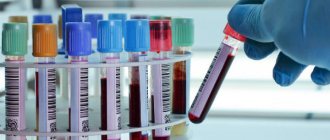Today you will learn all the most important things about blood sugar levels in children. Glucose (sugar) level is the most important indicator of human carbohydrate metabolism. Low sugar in a child or adult leads to hypoglycemia, accompanied by energy starvation of cells, decreased muscle contractility, muscle weakness, disruption of the central nervous system, etc.
Increased blood sugar in a child is observed with diabetes mellitus.
Diabetes mellitus is a severe chronic pathology in which carbohydrate metabolism is impaired, accompanied by decreased insulin secretion and an increase in blood glucose levels.
According to WHO statistics, type 1 diabetes occurs in every 500 children and every 200 adolescents worldwide.
In this regard, regular determination of blood sugar levels in children is the most important test to identify diabetes mellitus in the early stages. It should be noted that changes in blood glucose levels can be detected several years before the appearance of clear clinical symptoms of the disease.
Sugar levels in children and adults: what does this indicator depend on?
Due to the processes of glucose oxidation, complete energy metabolism in cells is maintained. Glucose and its metabolites are normally present in the cells of almost all organ and tissue structures of the body.
The main sources of glucose are sucrose and starch, amino acids and glycogen reserves of liver tissue.
Sugar levels are regulated by the pancreas (insulin, glucagon), pituitary gland (somatotropin, adrenocorticotropic), thyroid gland (thyroxine and triiodothyronine), and adrenal glands (glucocorticoids).
Insulin is the main hormone responsible for lowering blood glucose levels; other hormones are counter-insular, that is, they help increase blood sugar levels.
It should also be noted that the sugar level in venous blood is always lower than in arterial blood. This difference is due to the constant consumption of glucose from the blood by tissues.
Muscle tissue (skeletal muscle, cardiac muscle) and the brain respond most quickly to changes in blood glucose levels.
Why is glucose deficiency dangerous?
When blood glucose is low, brain function is disrupted. Its deficiency over a long period provokes swelling and damages the central nervous system, and the consequences can be irreversible. When a child experiences hypoglycemia, the ability to think normally is impaired and problems with coordination of movements appear.
Insufficient glucose levels can lead to hemorrhage in the eyes and the cardiovascular system is affected.
The most severe complication of the disease is hypoglycemic coma - this condition can develop in a few minutes and cause severe disturbances in the functioning of the brain and central nervous system. If timely medical assistance is not provided, breathing problems occur, which can lead to cardiac arrest and death.
Indications for determining blood glucose levels
Blood sugar levels must be checked when symptoms of hyperglycemia or hypoglycemia appear. It should be noted that in the early stages of the disease, the patient may experience only a few symptoms of changes in blood sugar levels. In this regard, the sooner a violation of glucose levels is identified and eliminated, the lower the likelihood of developing severe complications.
Indications for testing blood glucose levels are if the patient has:
- symptoms of hypoglycemia or hyperglycemia;
- suspicion of diabetes;
- obesity;
- severe pathologies of the liver and kidneys;
- diseases affecting the thyroid gland, adrenal glands, pituitary gland;
- suspicion of diabetes in pregnant women;
- impaired glucose tolerance;
- a history of diabetes in close relatives (such patients are recommended to be screened for diabetes mellitus once a year);
- severe vascular atherosclerosis;
- microcirculation disorders;
- gout;
- arterial hypertension;
- chronic infections of bacterial or fungal etiology;
- recurrent pyoderma (especially furunculosis);
- frequent cystitis, urethritis, etc.;
- polycystic ovary syndrome;
- frequent menstrual irregularities.
This analysis is also performed on newborns and pregnant women. An additional indication for testing blood glucose levels is a woman’s history of miscarriages, premature births, problems with conception, gestational diabetes mellitus, as well as the birth of large children, stillborn children, or babies with developmental defects.
Diabetes mellitus in newborns is rare, however, all children with high weight, developmental delay, stigmata of embryogenesis, etc., must be examined for diabetes mellitus and congenital hypothyroidism.
Patients over forty-five years of age, people with pancreatic diseases (pancreatitis) and people taking cytostatics, glucocorticoids and immunosuppressive therapy are also subject to regular examination.
Causes of hypoglycemia in newborns
Don't worry that your newborn is in danger due to low blood sugar. A variety of medical professionals will be on hand to ensure that the baby's health is safe. After he is born, your midwife and other staff will make sure he is digesting well. They will check the baby's glucose levels with blood tests. In some hospitals, these blood tests are routinely done on infants who are at high risk of hypoglycemia.
Every cell in our body needs a supply of sugar or glucose to function properly. Adults get glucose from food. Newborns get the sugar they need from their mother's breast milk. After eating, the sugar level rises. When it's time for the next feeding, sugar levels begin to drop and a feeling of hunger occurs. Sugar levels are regulated by hormones, specifically insulin, which helps certain cells take in glucose for storage. When everything is working well, hormones keep blood sugar levels within the proper range. When the balance is disrupted, hypoglycemia can occur.
Most healthy children can easily cope with normal low blood sugar levels.
What to do if you have diabetes?!
Read more >> |
When breastfed, the baby will drink breast milk whenever they want to eat. However, some babies are at risk, including those born to mothers who have diabetes. They may produce too much insulin, making them prone to low blood sugar.
Newborns are susceptible to hypoglycemia if they:
- Born prematurely or weighing very little
- had breathing difficulties at birth
- suffered from excessive cold or hypothermia
- they have an infection.
Hypoglycemia in newborns should usually resolve on its own. If the disease does not go away, the child will need to undergo an examination to find the root cause of the problem.
ul
Normal blood sugar
To determine the sugar level or monitor the progress of treatment, it is necessary to perform an appropriate blood test using a glucometer or in the usual laboratory way. Blood sampling can be done from the ring finger or vein. In the first case, the blood is called capillary because it is taken from small vessels - capillaries, and in the second case - venous. It must be taken on an empty stomach.
Blood sugar standards are approved by the World Health Organization and depend on what kind of blood is taken for analysis: capillary or venous. Capillary blood is more informative in this matter.
Adults
- capillary blood: 3.5-5.5 mmol/l (according to another system - 60-100 mg/dl).
- venous blood: 3.5-6.1 mmol/l.
- A blood sample taken after a meal will show a higher blood sugar level. A result of up to 6.6 mmol/l is considered normal, not higher.
Important! The result may be influenced by the following factors not related to pathological conditions of the body:
- chronic lack of sleep;
- stress;
- exacerbation of chronic diseases;
- pregnancy;
- smoking - both in general and immediately before blood sampling;
- internal diseases.
Frequency of blood sugar tests
- persons over 40 years old - once every six months;
- for patients at risk - once every 3 months;
- for patients with diabetes - on the recommendation of a doctor.
Pregnancy
Sugar control is necessary because it allows you to monitor the condition of the woman and the developing baby. During pregnancy, the tissue receptors of a pregnant woman are more sensitive to insulin, so the permissible range of blood sugar levels is slightly higher: 3.8-5.8 mmol/l. If the value is more than 6.1 mmol/l, a “Glucose Tolerance” test is required.
Sometimes, in the sixth month of pregnancy, gestational diabetes develops, in which the tissue receptors of a pregnant woman become insensitive to insulin produced by her own pancreas. In some cases, gestational diabetes may disappear after childbirth, but sometimes it develops into a full-fledged disease, especially with obesity or a hereditary predisposition. In this case, the woman should monitor her blood sugar and receive treatment.
Menopause
At this time, serious hormonal changes occur in the human endocrine system, so blood sugar levels may be elevated.
Children
Norms change with age:
- 2 days - 1 month - 2.8-4.4 mmol/l;
- 1 month - 14 years - 3.3-5.5 mmol/l;
- over 14 years old - 3.5-5.5 mmol/l.
ul
Important! How to use the glucometer
- Turn on the device (do not forget to keep spare batteries ready so that you can easily and quickly replace them if necessary).
- Wash your hands with soap and dry them. Wipe your finger with alcohol, dry it and stretch it.
- Make a puncture on the side of the pad of the middle or ring finger using the needle that comes with the device or is sold separately at the pharmacy.
- Remove the first drop of blood with cotton wool and place the next drop on the test strip.
- Insert it into the glucometer to determine the result (the numbers on the display indicate the amount of sugar, that is, glucose compounds in the blood).
- Record the result in the “Diary of monitoring the dynamics of the disease and ongoing treatment.” Do not neglect it: glucometer readings will help manage the disease.
Measurements are taken in the morning, immediately after waking up. Avoid eating breakfast, brushing your teeth, and exercising because any physical activity lowers your blood sugar.
It should be taken into account that the reference values of glucometers differ depending on the country of manufacture of the glucometer. In this case, tables are attached to help convert the obtained values into the values accepted in Russia.
The advent of glucometers is an important moment for diabetics: without reliable knowledge of blood sugar levels, insulin administration is prohibited. When glucose levels are low, they can be deadly.
ul
Complications of diabetes
Diabetes causes damage to small vessels - capillaries - in various organs. As a result, their blood supply is disrupted, and therefore nutrition. This causes serious complications:
- eye disorders: retinal hemorrhages, blepharitis, cataracts, glaucoma and blindness;
- renal disorders: chronic renal failure and uremia;
- disorders associated with the lower extremities: gangrene of the fingers and toes, as well as gangrene;
- plaque formation in large vessels (aorta, coronary arteries and cerebral arteries);
- polyneuropathy is a dysfunction of peripheral nerves. Patients feel numbness, a crawling sensation, cramps, pain in the legs, especially at rest, so they decrease when walking. Sometimes disorders associated with urination develop, and men are concerned about problems with potency.
Low sugar in a child
A decrease in blood sugar levels in a child (hypoglycemia) is manifested by the appearance of:
- increased aggressiveness, anxiety, excited and nervous behavior, irritability, tearfulness, unreasonable fear;
- profuse sweating;
- rapid heartbeat;
- tremors of limbs, convulsive seizures;
- pale, gray or bluish skin;
- dilated pupils;
- increased blood pressure;
- strong feeling of hunger;
- nausea, uncontrollable vomiting;
- severe muscle weakness;
- lethargy, drowsiness;
- impaired coordination of movements;
- headaches;
- disorientation in space and time;
- impaired perception of information, inability to concentrate;
- impaired skin and pain sensitivity;
- a feeling of goosebumps crawling on the skin;
- memory loss;
- inappropriate behavior;
- the appearance of double vision;
- fainting; with severe and progressive hypoglycemia, coma may develop.
Read further: All the causes of low sugar. Products and activities that quickly increase its level to normal
What to do if there is a deviation from the norm
Diabetes mellitus used to be considered a disease of older people. But studies show that the incidence among young people, adolescents, and children increases every year.
One of the causes of type 2 diabetes is excess weight. Constant overeating and large amounts of sugar-containing foods lead to high blood sugar in a child. As a result, glucose absorption is disrupted and tissue resistance to insulin develops.
If there are deviations from the norm in sugar tests, they change their lifestyle. The condition of prediabetes, in which children's blood sugar levels are higher than normal, is insidious. It may be asymptomatic. But its appearance indicates that changes have begun in the body that will subsequently destroy it.
You can correct it using:
- physical activity;
- proper nutrition;
- elimination of stress, emotional experiences;
- timely treatment of other diseases.
It is important to limit sugar-containing foods in children's diets. Children love sweets, the refusal of which causes misunderstanding and resentment. It is important to correctly explain to the child the need for such a step, set a personal example, and provide support.
Symptoms and signs of high sugar in children
An increase in sugar levels (hyperglycemia) can be manifested by the appearance of:
- constant thirst (polydipsia);
- frequent urination (polyuria), which can lead to dehydration;
- weight loss, despite a good appetite;
- constant fatigue and drowsiness;
- blurred vision, decreased vision;
- poor regeneration (even small scratches take a very long time to heal);
- constant dryness of mucous membranes;
- excessive dryness of the skin;
- constant itching of the skin and mucous membranes;
- frequent bacterial and fungal infections;
- menstruation disorders;
- vaginal candidiasis;
- recurrent external otitis;
- arrhythmias;
- rapid breathing;
- abdominal pain;
- acetone smell.
Read further: Normal blood sugar in women by age - critical level table
What sugar level is considered low?
Sugar levels vary depending on the age of the child. We can talk about hypoglycemia if the indicators fall below the following values:
- 2 mmol/l immediately after birth;
- 6 mmol/l up to one year;
- 2 mmol/l preschool children;
- 2 mmol/l schoolchildren under 17 years of age.
The disease develops most rapidly in infants, since their pancreas is not yet formed. The body of older children copes more easily with sugar fluctuations caused by intense metabolic processes.
How to donate blood to children for sugar
Three tests are used to detect glucose levels:
- examination of fasting sugar levels (examination is carried out in the morning, on an empty stomach);
- performing a glucose tolerance test;
- Determination of random sugar levels during the day.
The glucose tolerance test is not performed on children under fourteen years of age.
Fasting blood sugar levels must be determined on an empty stomach in the morning. At least eight hours must have passed since your last meal.
Before the study, emotional and physical stress should be excluded.
During the three days before the study, it is recommended, if possible, to stop taking oral contraceptives, thiazides, vitamin C, metopyrone®, corticosteroids, salicylates, phenothiazine®, etc.
You should avoid drinking alcoholic beverages at least one day before the test.
How is the analysis carried out?
For early detection of the disease, clinics and hospitals conduct blood tests for sugar in children and compare them with the norm. Laboratory tests provide accurate results that indicate the disease, predisposition to it or absence.
A blood test for sugar in children is usually taken from a finger, a drop of blood is enough. If a child is scheduled to donate blood from a vein, then there is no need to take capillary blood, since venous blood is also suitable for testing for sugar.
Before visiting the laboratory, you need to prepare so as not to distort the indicators:
- blood is donated in the morning on an empty stomach;
- before the analysis they do not eat breakfast or brush their teeth;
- the last meal should be 8-10 hours before the test;
- exclude foods with a high sugar content on the day preceding the analysis;
- avoid physical and psychological stress before analysis;
- exclude taking medications (after consultation with a doctor);
- You are allowed to drink water during this period of time.
It is important not to eat before visiting the laboratory, so exclude everything, even breast milk. Infants are fed 2-3 hours before analysis.
To test for sugar, a drop of blood from a capillary is enough. In young patients, it is possible to puncture the earlobe and heel to obtain a drop of blood for analysis.
The obtained indicators become the basis for further actions. If the figure exceeds the norm for glucose in children, then a glucose tolerance test is prescribed. To do this, the child drinks slowly (over 5 minutes) a concentrated glucose solution. Then, repeat samples are taken every half hour for two hours. This test determines glucose tolerance and detects the presence of diabetes.
What may affect the results of the study?
Falsely elevated test results can be detected in patients undergoing treatment with glucocorticosteroids, growth hormone, estrogens, caffeine, and thiazides.
Elevated sugar levels can also be detected in smokers.
Low blood sugar may occur in individuals being treated with anabolic steroids, propranolol®, salicylates, antihistamines, insulin®, or oral antihyperglycemic tablets.
Low sugar can also occur due to poisoning with chloroform or arsenic, in patients with leukemia or erythrocythemia.
Causes of hyperglycemia
Factors that contribute to increased blood sugar levels:
- viral infections that negatively affect the pancreas (chicken pox, measles, mumps, hepatitis);
- excess weight;
- low physical activity;
- poor nutrition, predominance of foods rich in carbohydrates in the diet;
- diseases of the thyroid gland or adrenal glands, hormone instability;
- hereditary predisposition to diabetes.
Hypoglycemia is provoked by the following factors:
- dehydration of the body;
- starvation;
- diseases of the gastrointestinal tract;
- blood diseases (lymphoma or leukemia);
- poisoning with drugs or chemical compounds;
- neoplasms that stimulate excessive insulin production.
Normal blood sugar levels in a child - table by age
The amount of sugar in children depends on age.
The normal blood sugar level for 1-year-old children ranges from 2.8 to 4.4 mmol/l.
The normal blood sugar level for a teenager is from 3.3 to 5.6.
Age standards:
| Age | Glucose level, mmol/l |
| Up to four weeks | 2, 8 — 4,4 |
| From four weeks to fourteen years | 3,3 — 5,6 |
| From fourteen to sixty years | 4,1 — 5,9 |
| From sixty to ninety years | 4,6 — 6,4 |
| After ninety years | 4,2 — 6,7 |
The criteria for probable diabetes mellitus are considered to be at least twice the determination of glucose levels above:
- seven - for fasting analysis;
- 1- for glucose tolerance tests (120 minutes after testing) in children over fourteen years of age;
- 1 for random determinations of sugar levels.
Causes of hyperglycemia
Hypoglycemia may occur in patients with:
- SD;
- natural increase in glucose levels (stress, physical overload, increased adrenaline levels);
- pheochromocytomas, thyrotoxicosis, acromegaly, Cushing's syndrome, somatostatinomas;
- cystic fibrosis, pancreatitis, malignant tumors, etc.;
- heart attacks, strokes;
- pathologies accompanied by the appearance of antibodies to insulin hormone receptors.
Hypoglycemia is detected if the patient has:
- adrenogenital syndrome, hypopituitarism, hypothyroidism, Addison's disease;
- ketotic hypoglycemia (typical for premature babies born to mothers with diabetes);
- severe liver pathologies;
- stomach or adrenal cancer;
- fever;
- exhaustion;
- fermentopathy;
- severe infections;
- insulinoma, glucagon deficiency.
Hypoglycemia can also occur in newborns with underweight, intrauterine infection, with a deficiency of breast milk in the mother, etc.
Useful video
Watch the video about blood sugar levels in children:
Similar articles
- How long do people live with diabetes: without treatment?
Many factors influence how long people live with diabetes: lifestyle, age at which the pathology was diagnosed, whether the patient is on insulin or pills, or whether a leg has been amputated. It is absolutely impossible to live without treatment. Women usually have a longer life expectancy; adaptation to insulin is worse in children. Read more - Insulin for gestational diabetes: which one is needed, when...
Insulin is prescribed for gestational diabetes when diet, herbs and lifestyle changes have not helped. Which one is needed for pregnant women? What dosages are prescribed for gestational diabetes mellitus? Read more
- Ultrasound of the pancreas for a child: preparation...
In some cases, an ultrasound scan of the child's pancreas is performed. It is important for a qualitative study to carry out preliminary preparation. What are the norms and deviations? Read more
- Hormones in children: how they affect, which ones to test...
Hormones in children are determined from the first days. The growth, intelligence, and functioning of the child’s organs depend on how they influence and their level. Which ones do you need to take? What will the transcript tell you about (the norm, why the level is increased, why the level is decreased)? Read more
- Suspicion of diabetes: examinations, tests, diet, what...
Diabetes may be suspected if there are accompanying symptoms - thirst, excessive urine output. Suspicion of diabetes mellitus in a child can only arise during a coma. General examinations and blood tests will help you decide what to do. But in any case, you will need a diet. Read more
Eating with low sugar
Low sugar can and should be dealt with. In addition to drug therapy, endocrinologists adjust the diet of the baby and the nursing mother if a lack of glucose is detected in the infant. Changes are also being made to the diet of older children. It is necessary to avoid baking, sweets, and caffeine-containing drinks. The most useful products that have a beneficial effect on the body during glycemia and prevent possible complications are:
- whole grain cereals;
- wholemeal bread and pasta;
- vegetables;
- fruits, especially apples;
- berries (blackcurrant, blueberry);
- lean meats;
- eggs;
- Fish and seafood;
- nuts;
- dairy and fermented milk products;
- herbal teas, compotes, juices.
You should eat repeatedly (5 times a day) in small portions, the size of which is determined by the age, level of motor and mental activity of the child. You should not reduce or increase the calorie content of your diet without consulting your doctor. This diet allows you to stabilize sugar and maintain the results for a long time. If a child has experienced low blood sugar, blood glucose levels should be measured regularly in order to take timely measures to treat this condition. You can learn how to do this at home and which glucometer to choose from the following video:
Low blood sugar: symptoms that should alert you
This article will look at a condition that is dangerous for humans - low blood sugar: the symptoms of this disease can remain unnoticed for a long time, attributed to ordinary fatigue.
Measuring sugar levels with a glucometer
Low sugar levels are no better than diabetes. The human body is in a critical situation, because the lack of glucose cannot properly nourish the internal organs necessary for life.
First of all, the brain suffers because it does not receive the necessary amount of sweetness for proper functioning. Work and core activities fade away, which can lead to complete shutdown. This condition is called hypoglycemic coma.
Knowledge of who may be at risk, what are the causes of the disease, how to avoid an unpleasant illness with the help of preventive actions, and how to recognize the symptoms if the disease has struck will help you avoid pushing the body to extremes. Hypoglycemia requires constant monitoring of sugar levels and proper treatment as prescribed by a doctor.
Causes of low sugar
Low-carbohydrate diets may lead to hypoglycemia
It seemed that constant monitoring of blood using a glucometer was the concern of diabetics. This statement is true, but it turns out that glucose levels can not only increase, but also systematically decrease.
For people with hypoglycemia, it is important not to bring the body to critically low levels. You need to know the reasons for a drop in blood sugar, which can occur even in a healthy person.
- Strong physical activity
. This item accommodates active sports and housework, which is very exhausting. With a normal diet, an energy deficit may occur, which will lead to excessive breakdown of glucose. - Poor nutrition
. It may occur as a result of maintaining a strict diet, poor food intake, or irrational food consumption. Internal reserves are affected, primarily carbohydrate reserves. - Hunger
. Sometimes, for certain reasons, a person spends a long time without food, which causes hypoglycemia. Low levels may occur after 8 hours without food. In the morning, values are often underestimated due to a long absence of food. - Large consumption of unhealthy foods
(soda, alcohol, sweets, candies) can significantly increase sugar, and then quickly reduce it below normal. - Pregnancy
can cause the condition in question. - A high content of foods that reduce sugar
(tomatoes, basil, garlic, eggplant, white cabbage).
Alcohol affects glucose levels
Sometimes, if blood sugar drops, this means the development of certain diseases:
- renal failure;
- development of infectious diseases;
- liver pathology;
- problems with the endocrine system;
- for diabetes mellitus, an excessive dose of insulin or tablets;
- change of medication;
- pathologies of the gastrointestinal tract;
- taking certain types of medications.
The dose of insulin must be accurately calculated by the doctor. TIP: the causes of low glycemic levels, as well as the causes of the appearance of sugar in the blood, can be dangerous or arise under the influence of a certain factor. It is necessary to pay close attention to your health and prevent the disease from developing.
Sudden surges in glucose
Hello, my name is Irina. Recently I measured my blood for sugar at home, the indicators were as follows: on an empty stomach 4.5 mmol/l, after meals 13 mmol/l. The latter value decreased slowly, after 2 hours it reached 9 mmol/l. Is this normal behavior of the body?
Hello Irina.
Your postprandial readings are too high, even after a couple of hours. This indicates a possible health problem. The causes of high blood sugar are varied, the most common being diabetes. You should see a doctor to be tested for medical conditions.
Hidden diabetes is difficult to recognize











